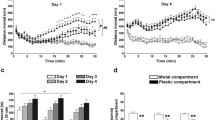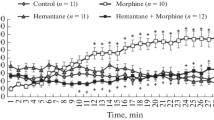Abstract
Three histamine H1-receptor antagonists, chlorpheniramine, diphenhydramine and tripelennamine, were tested alone or in combination with morphine, amphetamine and scopolamine on locomotor activity in mice. All three antihistaminics, at some dosage levels, enhanced morphine-induced hyperactivity, but did not change or even reduce locomotor stimulation induced by amphetamine and scopolamine. The results suggest that H1-blocking agents may specifically interact, though not necessarily directly, with opiate mechanisms in producing behavioural effects.
Similar content being viewed by others
References
Bluhm RE, Evans MA, Zsigmond EK (1983) Analgesic potentiation and the distribution of morphine in the presence of tripelennamine in mice. Life Sci [Suppl I] 33:673–676
Douglas WW (1985) Histamine and 5-hydroxytryptamine (serotonin) and their antagonists. In: Goodman Gilman A, Goodman LS, Rall TW, Murad F (eds) The pharmacological basis of therapeutics. 7th Ed. MacMillan, New York, pp 605–638
Garattini S, Samanin R (1981) The pharmacological profile of some psychomotor stimulant drugs including chemical, neurophysiological, biochemical, and toxicological aspects. In: Hoffmeister F, Stille G (eds) Psychotropic agents. Part II: Anxiolytics, gerontopsychopharmacological agents, and psychomotor stimulants. Springer, Berlin, pp 545–586
Grosset D, Wallace S, Picker M, Poling A (1984) Tripelennamine and pentazocine alone and in combination: Effects on interresponse-time-greater-than-t responding of rats. Pharmacol Biochem Behav 20:697–700
Lahmeyer HV, Steingold RG (1980) Pentazocine and tripelennamine: A drug abuse epidemic. Int J Addict 15:1219–1232
Oliverio A, Castellano C, Puglisi-Allegra S (1984) Psychobiology of opioids. Int Rev Neurobiol 25:277–337
Poling A, Kesserling J, Sewell RG, JR, Cleary J (1983) Lethality of pentazocine and tripelennamine combinations in mice housed individually and in groups. Pharmacol Biochem Behav 18:103–105
Poling A, Sewell RG, JR, Gallus JA, Nearchou NI (1985) Lethality of opioid and antihistaminic combinations in mice. Pharmacol Biochem Behav 22:333–335
Sansone M (1982) Opposite effects of chlordiazepoxide and serotonin receptor antagonists on morphine-induced locomotor stimulation in mice. Psychopharmacology 78:54–57
Sansone M, Castellano C, D'Amato FR (1986) Enhancement of morphine-induced hyperactivity by antihistaminic drugs in mice. Arch Int Pharmacodyn 284:239–245
Shannon HE, Su TP (1982) Effects of the combination of tripelennamine and pentazocine at the behavioral and molecular levels. Pharmacol Biochem Behav 17:789–795
Showalter CV (1980) T's and blues: Abuse of pentazocine and tripelennamine. JAMA 244:1224–1225
Sun CLJ, Hui FW, Hanig JP (1985) Effect of H1 blockers alone and in combination with morphine to produce antinociception in mice. Neuropharmacology 24:1–4
Tagashira E, Kachur JF, Carter WH, JR, Dewey WL (1984) Potentiation of narcotic-induced antinociception by tripelennamine in morphine-tolerant and drug-naive mice. J Pharmacol Exp Ther 229:214–217
Waller DP, Katz NL, Morris RW (1980) Potentiation of lethality in mice by combinations of pentazocine and tripelennamine. Clin Toxicol 16:17–23
Yeh SY (1986) The effect of anthistaminic drugs on pentazocine antinociception in the rat. Pharmacol Biochem Behav 24:925–930
Author information
Authors and Affiliations
Rights and permissions
About this article
Cite this article
Sansone, M., D'Udine, B., Renzi, P. et al. Antihistaminics enhance morphine-, but not amphetamine-and scopolamine-induced hyperactivity in mice. Psychopharmacology 93, 155–157 (1987). https://doi.org/10.1007/BF00179926
Received:
Revised:
Issue Date:
DOI: https://doi.org/10.1007/BF00179926




